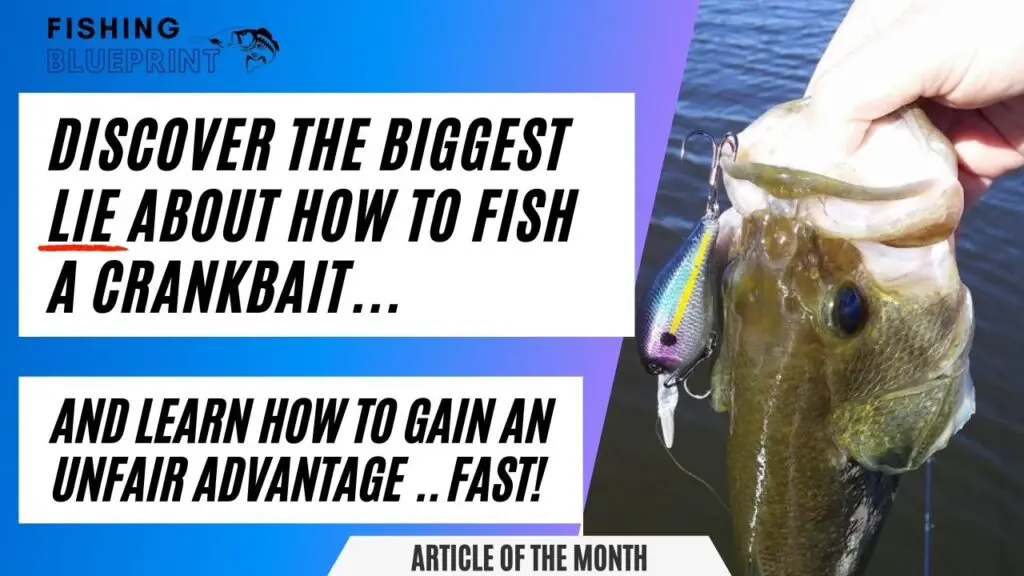How To Fish Woods Canyon Lake
Woods Canyon Lake Fishing Report
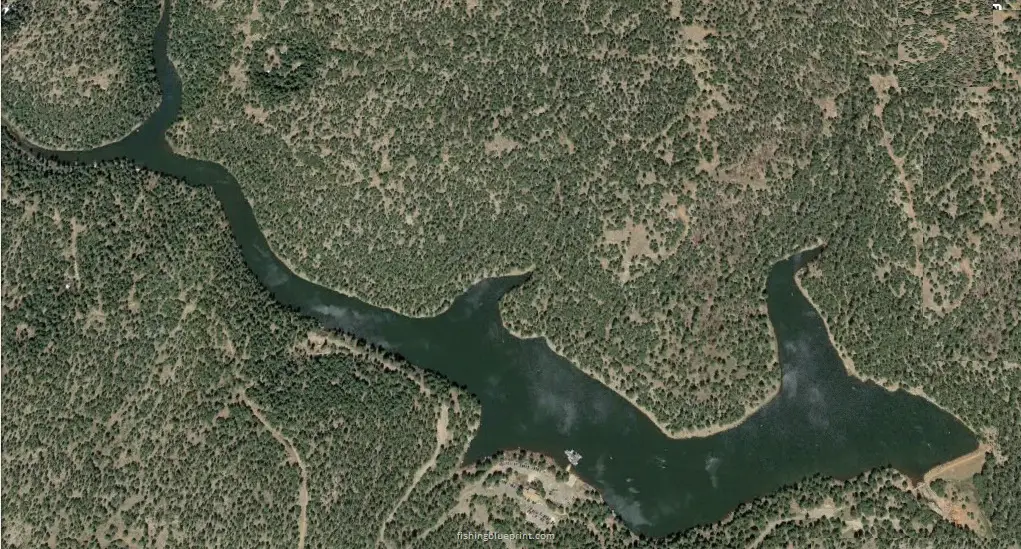
Woods Canyon Lake is a small lake that sits 122 miles away from Phoenix, Arizona.
Overall it’s a popular lake being nestled in part of the northeastern part of the state on the Mogollon Rim. In this post you’re going to be given the blueprint to fish this lake.
So what are the best tips for fishing Woods Canyon Lake? There are three important factors you must know if you want to know how to fish Woods Canyon Lake successfully. First, you need to know what kind of fish is in Woods Canyon Lake. Second, it’s important for you to know which part of the lake each species can be found. Lastly, knowing what are the best baits that work on Woods Canyon Lake is vital. However, tactics, baits, and locations will be different for each type of fish that you target. So let’s talk about the steps you need to take in order to give you the best chance of catching a fish on Woods Canyon Lake.
WARNING: There’s a lot of information about this subject you’ll probably want to come back to. No one expects you to remember all these tips. We know your time is precious, so we really tried to over-deliver in value for you. Additionally, we frequently update reports like this, so you’ll want to stay up to date with any changes or additional tips we include for you.
We found that the easiest way to save and bookmark this report so you can come back to it later is to share it on your favorite social media platform, especially if you use your phone to get important tips like the ones in this report here…
Click on your favorite social media buttons to remember this page now!
About Woods Canyon Lake
Woods Canyon Lake is a relatively deep body of water with the average depth being 30 feet and a maximum depth of 60 feet when the lake is completely full. Woods Canyon Lake is 55 acres, is approximately 1 mile long and 0.25 miles across. This reservoir plays a vital role in snowfall runoff retention. This lake gives locals and visitors the opportunity to test their luck in catching rainbow trout, tiger trout, brown trout, largemouth bass, smallmouth bass, sunfish, and catfish.
Important Lake Warnings
Algae blooms may be present which may affect fishing, swimming, and water contact in general.
Maximum 10-HP for gas engines on the lake.
If you are fishing and camping, fire bans may be in effect due to the ongoing drought conditions.
Key Species at Woods Canyon Lake
- Rainbow Trout
- Brown Trout
- Tiger Trout
- Largemouth Bass
- Smallmouth Bass
- Black Crappie
- Sunfish
- Catfish
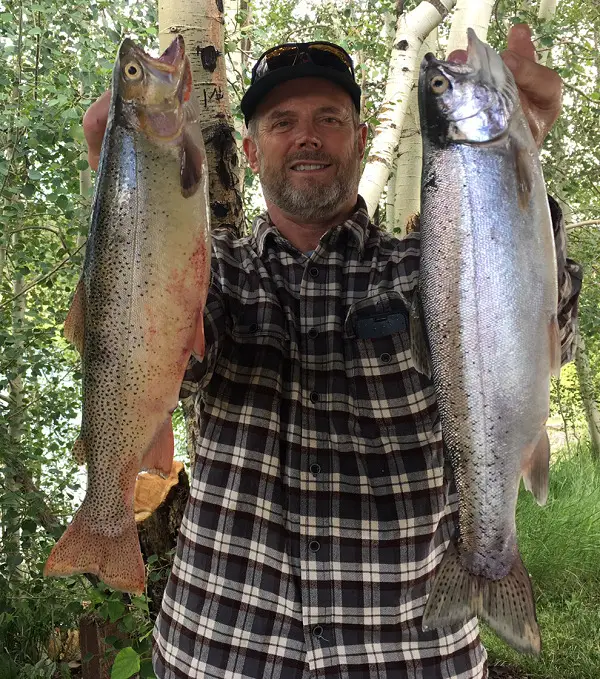
Woods Canyon Lake Fishing Tips & General Strategies
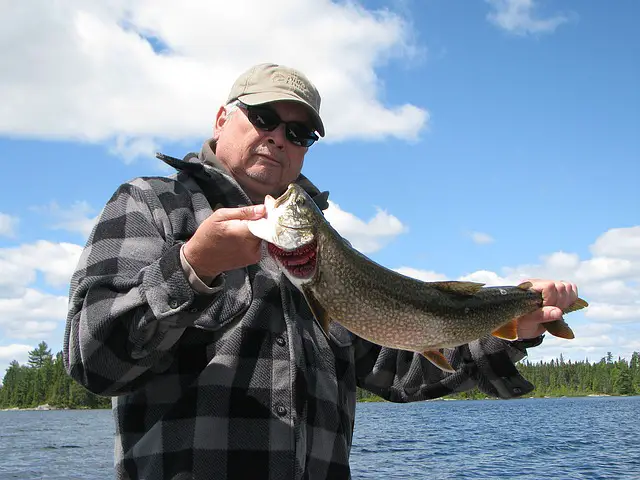
It can be a challenge to break down Woods Canyon Lake and decide to get started.
Getting started, Woods Canyon Lake is a stained water lake and fishing can be tough.
The primary structures are going to be a large creek channel that runs down the middle of the lake.
The banks vary from semi-steep to gentle sloping. Most banks consist of chunk rock and pea-gravel. Some areas have sand and clay.
By far you’ll have the best opportunity to catch a fish if you can present your bait to fish that are in deep water.
Trout in this lake are extremely pelagic and hunt in small schools.
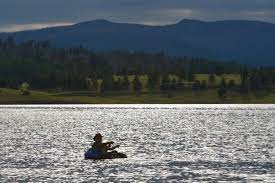
This lake is absolutely beautiful, open, and accessible to nearly everybody. It’s convenient since there are paths that go along the lake’s shore.
Often you’ll see a huge herd of Elk grazing on the hills is regularly visible in the early morning and late evening.
You can easily fish from the shore or from a boat or kayak.
Trout can be found up shallow in the winter and spring. However, trout will often suspend over deep water and more importantly in water temperatures that range from 55.5-56.5-degrees.
Your best chance of catching deep suspending rainbow trout is by trolling your lure with a quality downrigger. Otherwise, you can drift or slow troll trout using a fly, corn, wax worm, salmon egg, or PowerBait.
But where are the best places to fish At Woods Canyon Lake?
And in no particular order here is that list of the best fishing spots at Woods Canyon Lake.
DISCLAIMER: The material provided is for general information purposes only. It’s important to understand that any information provided in this article can change at any time. Any maps or graphics featured are not to be used as navigational aids. Fishing Blueprint will not be responsible for any personal injury or property damage from any misuse of the maps or graphics provided. It’s completely impossible to give you every single spot where you can potentially catch a fish. But, what this list does do is to give you a helping hand and narrow down to the most productive fishing spots.
Woods Canyon Dam
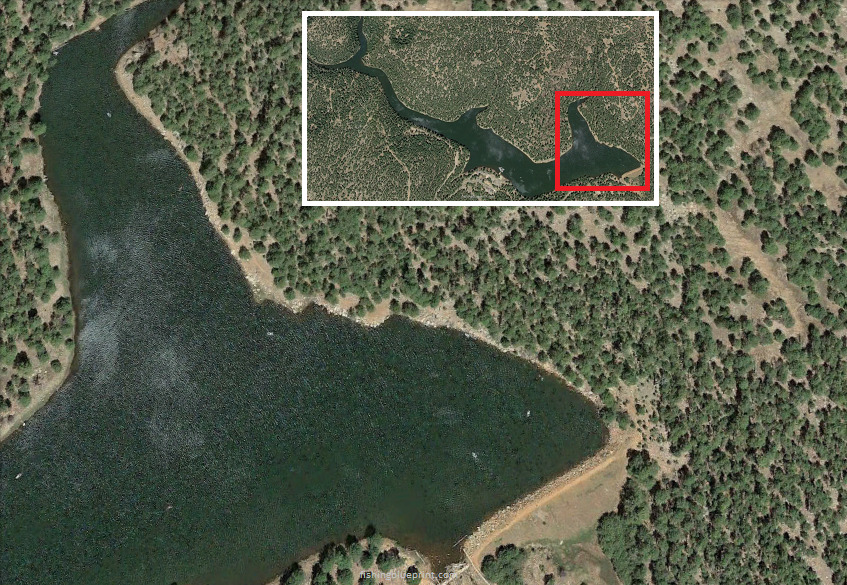
Fishing around the dam provides you access to the deepest water this lake has to offer.
If you fish from a boat or kayak, it’s important that you graph this area to see what depth the trout are holding at. Then you can easily adjust your lure depth to just above the suspending depth.
This section of the lake can get very windy. And even with the best trolling motor the wind can quickly blow you off your spot which will significantly decrease your chances of catching a fish..
That is why we strongly suggest buying a quality drift sock. For those who don’t know, a drift sock is like a parachute for the water. If it’s breezy to windy, you need to slow your drift otherwise your lure will not be in the strike zone long enough to catch a fish.
By the way, we found a really good quality drift sock made by Mythik Outdoors, and best of all they’re sold on Amazon.com. Go here to learn more about drift socks and read the reviews from actual customers.
Some of the effective baits for this area include:
But wait! Before you tie on any bait nearly every professional fishing guide will strongly encourage the use of a fish attractor like a quality flasher or dodger 2-3 feet in front of any lure. This helps get the fish’s attention, kinda like ringing a dinner bell!
Trolling spoons such as a Krocodile spoon, Super Duper, Crippled Herring, Cast Champ, or Hus-Lure. Trolling spoons have an unpredictable, minnow-like motion that delivers bone-crushing strikes. Even the slowest current brings these lures to life. Add extra motion by twitching the rod tip and enabling the bait to pop and dart forward and flutter back.
Inline spinners such as the Bang-Tail and Shyster are non-twist spinners that boast an immediate spin blade design for incredibly rapid start-ups and the best slow retrieve performance.
Many anglers also place their confidence in the Blue Fox Classic Vibrax inline spinner. This little bait is a compact shallow running lure that performs best in 2 to 6 feet of water, depending on the speed of the retrieve or trolling speed. The patented two-part body emits low-frequency sound vibrations that attract fish. This lure is best used in lakes, rivers, and streams.
Minnow style baits also work very well either cast-and-retrieved or trolled. These perform best if the water is clear/slightly stained. The Luhr-Jensen Quick Fish and the Rapala BX minnow are constructed from hard plastic, have a wide wobble action, and are extremely durable. Whereas the Rapala Original Floating Minnow and the Ultra Light Minnow (all are slow sinking) both give you a tighter wobble perfect for clear water and pressured fishing conditions.
Better yet, just buy a complete done-for-you trout lure kit!
Now if you’re fishing from the shore, kayak, or even from the shore you should also consider using these additional baits:
- Real or artificial corn – great because it will never spoil or mold over
- Natural salmon eggs – it’s hard to beat natural salmon eggs when trout are eating salmon eggs, they’ll eat up jars of this stuff!
- Artificial salmon eggs – great because they float off the bottom – ideal in rocky or grassy conditions
- Real worms – such as meal worms or nightcrawlers
- Artificial worms – great for trolling and will never die)
- Dough bait – great because they stay on the hook really well, it floats if you put enough on the hook, comes in a variety of colors and scents.
- Wet flies (sinking flies) – Wet flies imitate insects that develop and inhabit below the water level before emerging and rising to the surface.
- Woolly bugger flies – One of the most popular fly patterns ever is the Woolly Bugger. These mimic small fish, leeches, larvae, and worms.
.
Oh, before I forget, did you know that there is an article about how to troll for salmon, trout, and kokanee the right way? Go here to find out more.
If you’re fishing from the shore during the summer anywhere in this area I would strongly recommend it.
Smallmouth bass and bluegill prefer to live close to the rocks. Smallmouth bass can be caught using smaller crankbaits, soft plastic swimbaits, and drop shot.
Bluegill can be caught with a simple bobber and small #12 hooks with a bread ball, corn, or even a small piece of Slim Jim (don’t laugh, it works).
Effective baits for bass include: topwater lures, crankbaits, soft plastic swimbaits, spinnerbaits, chatterbaits, jerkbaits, swim jigs, hair jigs, and underspin jigs when the bass are aggressive.
If the bass are timid, then drop shot, tubes, Ned rig, Neko rig, Mojo rig, Carolina rig and football jigs all work really well.
Located: south end of the lake
Structural features: deep water
Best species to target: trout, bass, sunfish, catfish
Most effective way to fish this spot: boat, kayak, float tube, shoreline
Main Marina Channel
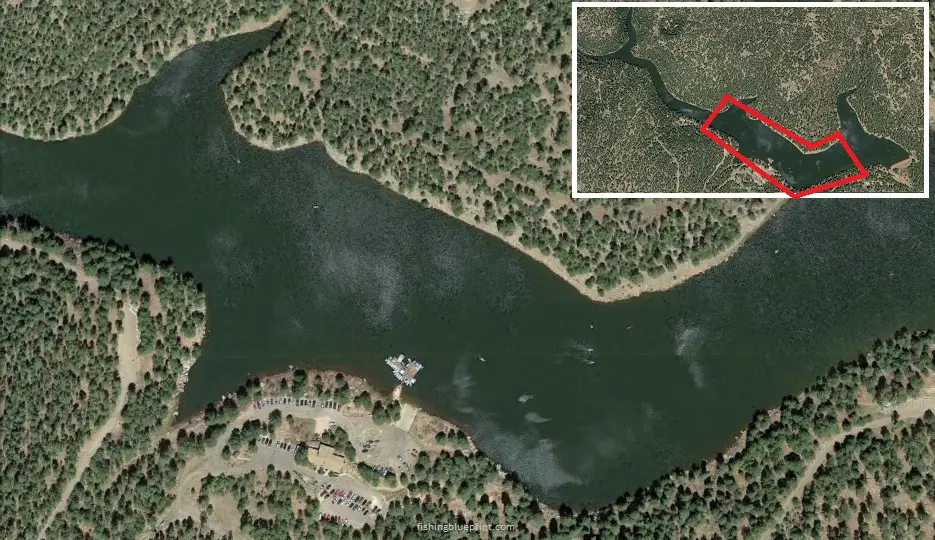
This area features a deep channel with semi steep rocky banks.
Trout can be caught shallow in the mornings and evenings and will retreat to deep water during midday.
Towards the end of the summer and early fall weeds can grow thick which makes for great largemouth bass fishing.
You can catch smallmouth and largemouth near any rocky edges, points, boulders, and vertical timber.
Some of the effective baits for trout include: For trolling; Fish attractor (ie: flasher or a dodger), trolling spoons, inline spinners, Rapala minnows, flatfish, streamers and flies, and wedding ring spinners. For non-trolling methods; corn, wax worms, salmon eggs, trout dough bait (ex: PowerBait) and flys.
Effective baits for bass include: topwater lures, buzzbaits, crankbaits, chatterbaits, soft plastic swimbaits, spinnerbaits, jerkbaits, swim jigs, hair jigs, and underspin jigs when the bass are aggressive. Flutter spoons work great when used over any deep structure or vertical timber as well.
If the bass are timid, then drop shot, tubes, Ned rig, Neko rig, Mojo rig, Carolina rig, and football jigs all work really well.
Located: middle of the lake of the lake
Structural features: deep channel
Best species to target: trout, bass, bluegill, catfish
Most effective way to fish this spot: boat, kayak, float tube, shoreline
Upper Creek
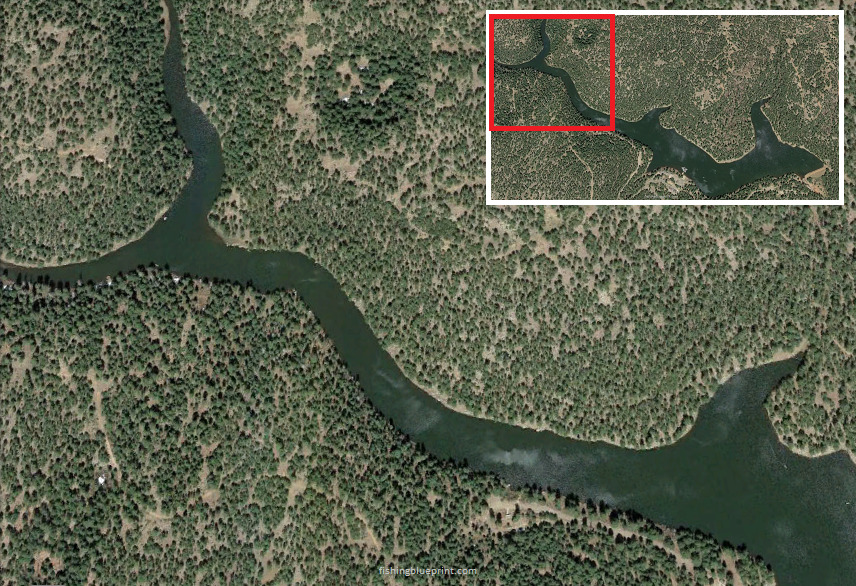
This spot is defined by a long channel that is narrow and relatively deep.
It has multiple points, ledges, ridges, drop offs, and humps. This means you have many different structures you can target and fish.
Trout can be caught in the winter and spring.
Bass and other warm-water fish can be caught here all year long.
The most productive areas will be where any channels or ditches are close to another type of structure (such as points, ledges, ridges, drop offs, or humps), or close to some form of cover (vegetation, laydowns, vertical standing timber, rock pile, boulder, or any other form of artificial structure).
Before trying to fish everything, be sure to take some time and scan these areas first with your fish finder to see if there are any bait or bass relating to that particular spot. If you see bait or bass in the spot then fish it.
Effective baits for this area include: crankbaits, soft plastic swimbaits, spinnerbaits, jerkbaits, chatterbaits, swim jigs, hair jigs, and underspin jigs when the bass are aggressive. Flutter spoons work great in the deeper channel sections as well.
If the bass are timid, then drop shot, tubes, Ned rig, Neko rig, Mojo rig, Carolina rig, and jigs all work really well.
Located: northern side of the lake
Structural features: deep channel, points, ledges, ridges, drop offs, and humps
Best species to target: trout, bass, bluegill, catfish
Most effective way to fish this spot: boat, kayak, float tube, shoreline
How To Catch A Fish In Woods Canyon Lake
Rainbow Trout
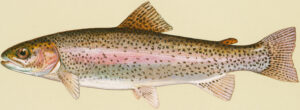 Arizona Game & Fish Department grow and stocks local lakes and reservoirs like this lake with Rainbow Trout.
Arizona Game & Fish Department grow and stocks local lakes and reservoirs like this lake with Rainbow Trout.
Due to this lake being relatively unpressured, deep, and colder, and most other desert reservoirs, the stocked trout do very well.
Since the trout are produced in local fisheries, they are healthy and have no limit on the amount of trout that can be consumed.
Typically trout are stocked twice a week, however, it can vary.
General Trout Details
Spawn: March-May
Food: insects and crustaceans.
Arizona State Record: 15 lb. 9.12 oz. 32.5 in., Willow Springs Lake Harold Wright, Sun City 9/29/06
Table Quality: Depending on the fishes diet, the meat can be white to orange-red in color. The meat is firm, flaky, and is considered excellent eating.
Angling techniques:
- Trolling with or without downriggers
- Fish attractor such as a flasher or a dodger – great when trolling.
- Trolling spoons such as a Krocodile spoon, Super Duper, Crippled Herring, Cast Champ, or Hus-Lure – simple, easy to use, can be trolled or cast-retrieved at any speed.
- Inline spinners such as the Bang-Tail and Shyster – gets a ton of bites.
- Minnow style baits such as the Luhr-Jensen Quick Fish and the Rapala BX minnow – known to hook up giant fish.
- Real or artificial corn – great because it will never spoil or mold over.
- Natural salmon eggs – it’s hard to beat natural salmon eggs when trout are eating salmon eggs, they’ll eat up jars of this stuff!
- Artificial salmon eggs – great because they float off the bottom – ideal in rocky or grassy conditions.
- Real worms – such as meal worms or nightcrawlers.
- Artificial worms – great for trolling and will never die.
- Dry flies (floating flies) – The insects that land, float, or live on top of the water, which are represented by dry flies.Investing in a kit gives you a wide assortment of flies and a good selection of types and sizes allow you to quickly adjust to any situation.
- Wet flies (sinking flies) – Wet flies imitate insects that develop and inhabit below the water level before emerging and rising to the surface. Investing in a kit gives you a wide assortment of flies and a good selection of types and sizes allow you to quickly adjust to any situation.
- Woolly bugger flies – One of the most popular fly patterns ever is the Woolly Bugger. These mimic small fish, leeches, larvae, and worms. Investing in a kit gives you a wide assortment of flies and a good selection of types and sizes allow you to quickly adjust to any situation.
Steamer flies – They can also mimic larger animals found in streams and rivers, including crawfish, larger leeches, and smaller fish. Investing in a kit gives you a wide assortment of flies and a good selection of types and sizes allow you to quickly adjust to any situation.
- **The number one key to successful trout fishing, is to use light line (2 to 6 pound) and small hooks (10-14 sizes), and small sinkers
Brown Trout
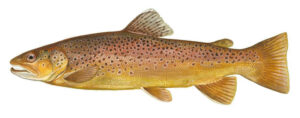 In Arizona, this is the only fish with both red and black patches on its body.
In Arizona, this is the only fish with both red and black patches on its body.
A pale/off-white halo usually surrounds dark patches on the sides.
On the back, the color ranges from dark to olive brown, dipping to yellow on the sides, and yellow or white on the belly.
In larger fish, breeding males have lower chin that will create a hooked jaw. The corner of the mouth extends past the eye, resulting in a huge mouth.
Brown trout are not native to Arizona, nor to North America for that matter. They were first imported to California in 1893 and originated in Europe.
Brown trout will commonly feed during the day if they are not bothered. Larger fish, on the other hand, are mainly nocturnal.
Brown trout are very aggressive feeders and will readily eat a streamer fly, casting upstream or into the wind.
Artificial baits such as in-line spinners or small Rapala minnow bait work phenomenally.
Live nightcrawlers, or minnows on a #6-#8 hooks are excellent baits.
If you can find any waterfall or spillway, spend some time fishing it because brown trout will often wait to ambush any prey that happens to drift over them in those areas.
Likewise, if you’re in a boat on the main lake some of the best ways to catch brown trout is to troll for these behemoths.
General Trout Details
Spawn: October-December
Food: Insects, small fish and crustaceans.
Arizona State Record: 22 lbs 14.5 oz. Caught 08/06/1999 in Reservation Lake.
Table Quality: Depending on the fishes diet, the meat can be white to orange-red in color. The meat is firm, flaky, and is considered excellent eating.
Angling techniques:
- Trolling with or without downriggers
- Fish attractor such as a flasher or a dodger – great when trolling.
- Trolling spoons such as a Krocodile spoon, Super Duper, Crippled Herring, Cast Champ, or Hus-Lure – simple, easy to use, can be trolled or cast-retrieved at any speed.
- Inline spinners such as the Bang-Tail and Shyster – gets a ton of bites.
- Minnow style baits such as the Luhr-Jensen Quick Fish and the Rapala BX minnow – known to hook up giant fish.
- Real or artificial corn – great because it will never spoil or mold over.
- Natural salmon eggs – it’s hard to beat natural salmon eggs when trout are eating salmon eggs, they’ll eat up jars of this stuff!
- Artificial salmon eggs – great because they float off the bottom – ideal in rocky or grassy conditions.
- Real worms – such as meal worms or nightcrawlers.
- Artificial worms – great for trolling and will never die.
- Dry flies (floating flies) – The insects that land, float, or live on top of the water, which are represented by dry flies.Investing in a kit gives you a wide assortment of flies and a good selection of types and sizes allow you to quickly adjust to any situation.
- Wet flies (sinking flies) – Wet flies imitate insects that develop and inhabit below the water level before emerging and rising to the surface. Investing in a kit gives you a wide assortment of flies and a good selection of types and sizes allow you to quickly adjust to any situation.
- Woolly bugger flies – One of the most popular fly patterns ever is the Woolly Bugger. These mimic small fish, leeches, larvae, and worms. Investing in a kit gives you a wide assortment of flies and a good selection of types and sizes allow you to quickly adjust to any situation.
Steamer flies – They can also mimic larger animals found in streams and rivers, including crawfish, larger leeches, and smaller fish. Investing in a kit gives you a wide assortment of flies and a good selection of types and sizes allow you to quickly adjust to any situation.
- **The number one key to successful trout fishing, is to use light line (2 to 6 pound) and small hooks (10-14 sizes), and small sinkers
Largemouth Bass
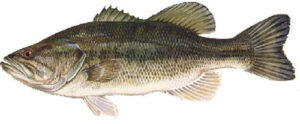 The Largemouth bass is a carnivorous member of the sunfish family. Most lakes hold the Northern strain species, however the Roosevelt chain lakes have been stocking the lakes with Florida strain species of largemouth bass.
The Largemouth bass is a carnivorous member of the sunfish family. Most lakes hold the Northern strain species, however the Roosevelt chain lakes have been stocking the lakes with Florida strain species of largemouth bass.
The Northern strain is thought to be considered more aggressive and offers a better fight than their Florida strain cousins. Whereas, the Florida strain can grow to an enormous size.
Listed below are a handful of facts, top spots, and best lures to use to help you out…
If you’re still not sure how to catch a bass, do worry. A complete section on Bass Fishing 101 was written to help you out. In that section, you’ll learn about the top ways to get you catching bass fast.
Read more: Beginner’s Guide To Bass Fishing Basics – Tips, Secrets & Things To Avoid
General Largemouth Bass Details
Spawn: Spring, March-May
Food: Shad, bluegill, crayfish
Arizona State Record: 16 lb. 7.68 oz. 28.0 in., Canyon Lake Randall E. White, Mesa 4/22/97
Table Quality: Decent. Firm white meat.
Angling techniques:
Smallmouth Bass
 Smallmouth bass are a sibling species closely related to largemouth bass. They have a pretty brown/golden color and carry the nickname of “bronzeback”. There are a few physical features that make it different from the largemouth bass. Aside from being bronze in color, they will have gray-brown vertical bands and the most defining feature is the jaw does not extend past its eye.
Smallmouth bass are a sibling species closely related to largemouth bass. They have a pretty brown/golden color and carry the nickname of “bronzeback”. There are a few physical features that make it different from the largemouth bass. Aside from being bronze in color, they will have gray-brown vertical bands and the most defining feature is the jaw does not extend past its eye.
Overall, smallmouth bass are most likely going about half the size of largemouth bass. However, pound for pound, a smallmouth can be incredibly aggressive and will put up an amazing fight.
General Smallmouth Bass Details
Spawn: March-May
Food: fish, crustaceans.
Arizona State Record: 6 lb. 4.48 oz. 21 in. Lake Havasu Sue Nowak, 2/23/17
Table Quality: Similar to a largemouth bass it’s firm, white, flaky, mild-tasting
Angling techniques:
- Finesse jigs
- Mojo Rig
- Neko Rig
- Small crankbaits
- Football Jigs
- Soft plastic swimbaits
- Jerkbaits
- Chatterbaits
- Swim jigs
- Hair jigs
- Underspin jigs
- Drop shot plastic worms
- Tubes
- Streamer flies.
- Live baits: minnows, hellgrammites, and crayfish
Black Crappie
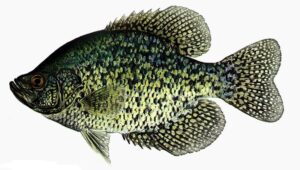 Introduced to Arizona in 1905, this lakes holds black crappie. These fish tend to linger over submerged brush and timber and are found in schools.
Introduced to Arizona in 1905, this lakes holds black crappie. These fish tend to linger over submerged brush and timber and are found in schools.
The black crappie are much more tolerant in cooler water than their white crappie cousins.
Black crappie can be described as having an irregular black dots and blotched on the back and have more of a “silvery-olive” background.
Average weight of a crappie in is going to be 0.75-pounds, however electro-netted samples show they can get over 3-pounds in size!
General Crappie Details
Spawn: April – mid-June
Food: Larvae, small fish, and crustaceans. Threadfin shad make up their main diet.
Arizona State Record: 4 lb. 10.0 oz. –in., San Carlos Lake John Shadrick, Mammoth 1959
Table Quality: The meat is excellent. It’s firm, flaky and white.
Angling techniques:
- Live minnows under bobbers
- Crappie jigs
- Crappie tubes
- Silver spoons
- Spinners
Catfish
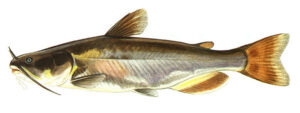
Channel catfish weight will range from 0.5-to-15-pounds in and of the Roosevelt chain lakes, including Canyon Lake. However, the average weight will be between 1-4-pounds.
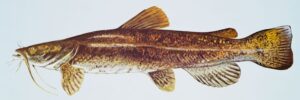
Conversely, “smaller” flathead catfish will weigh in at 15-pounds and can grow around 75-pounds. A flathead survey conducted in 2016 and 2020 caught a flathead that weighed over 48-pounds!
General Catfish Details
Spawn: March-June
Food: Carp, bluegill
Arizona State Record:
Channel catfish – 33 lb., 5.76 oz., 39.5 in., Upper Lake Mary Carson Pete, 3/26/17
Flathead catfish – 76 lb. 8.64 oz., 53.5 in., Bartlett Lake Eddie Wilcoxson, Surprise 04/13/13
Table Quality: Soft white meat. In the summer the meat will taste muddy.
Angling techniques:
Flathead catfish:
- live bait such as smaller carp, full sized bluegill, or tilapia
Channel catfish:
- chicken liver
- hotdogs
- stink bait
- small bluegill
- small carp
Bluegill/ Sunfish
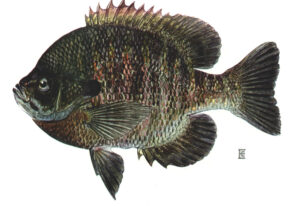 Introduced to Arizona in 1932, the bluegill has teal-blue coloring on the bottom portion of the chin and gill plate. It also has a solid black opercula flap just behind the gill plate.
Introduced to Arizona in 1932, the bluegill has teal-blue coloring on the bottom portion of the chin and gill plate. It also has a solid black opercula flap just behind the gill plate.
Bluegill are found on the shoreline and prefer nearby structures. Bluegill are incredibly aggressive and will quickly attack anything that looks like it could be eaten. Due to their aggressive behavior, they are one of the easiest fish to catch and are a great way to introduce someone to fishing.
Spawn: April and May
Food: Small fish and insects
Arizona State Record: 3 lb. 15.68 oz. 15.75 in., Goldwater Lake. Christopher Ray Mapes, Prescott Valley 5/2/04
Table Quality: Firm, white meat
Angling techniques:
- Worms
- Dough balls
- Slim jim sausages pieces on a small hook (not lying… it really works)
- Small spinners
- Trout flys
Carp
Carp are an oily freshwater species of fish and are native to Europe and Asia. Carp are considered invasive to the United States.
The big, hard fighting fish are really fun to catch. Many anglers will fish for carp at night and bowfishing from the shore or from a boat!
Carp can be consumed however, their muddy taste and boney meat make it one of the least desirable fish to eat.
Spawn: March-June
Food: algae, plant matter, fish eggs, insects, aquatic worms, small crustaceans (snails), and small crayfish
Arizona State Record: 37 lb. 0.0 oz. 40.0 in., Bartlett Lake Jonathan Gardner, Phoenix 8/8/87
Table Quality: Poor. Soft white flesh that is muddy and riddled with bones
Angling techniques:
- Dough balls
- Corn
- Worms
- Cherry tomatoes (not kidding)
- Commercial carp baits
Boat Ramps at Woods Canyon Lake
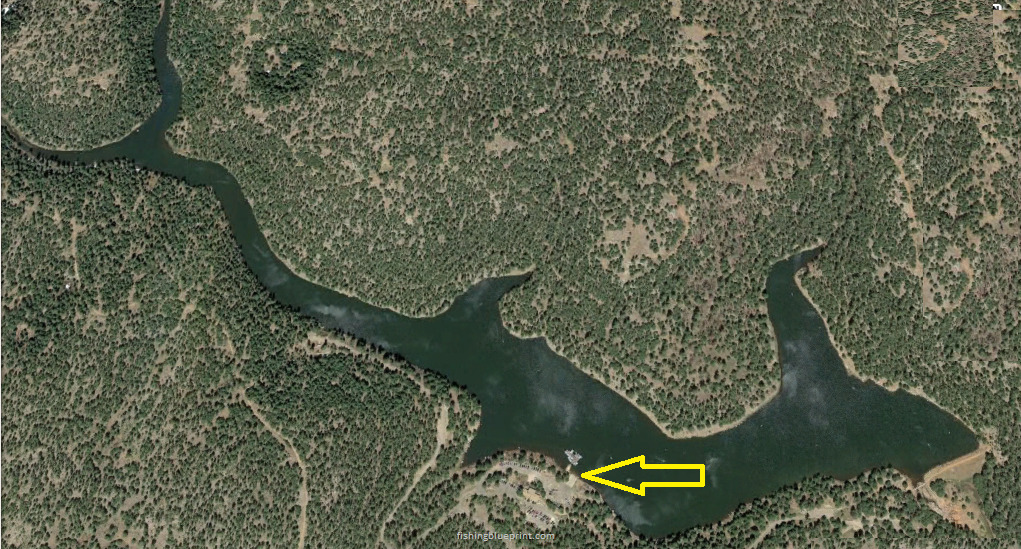
Woods Canyon Boat Ramp
Location: west side of the lake (follow the signs)
Phone number: none
Nearby boat ramp: 2
Groceries available: no
Gas: no
Bathrooms: yes
Showers: no
Electric: no
Camping nearby: yes
Top Tackle Shops Near Woods Canyon Lake
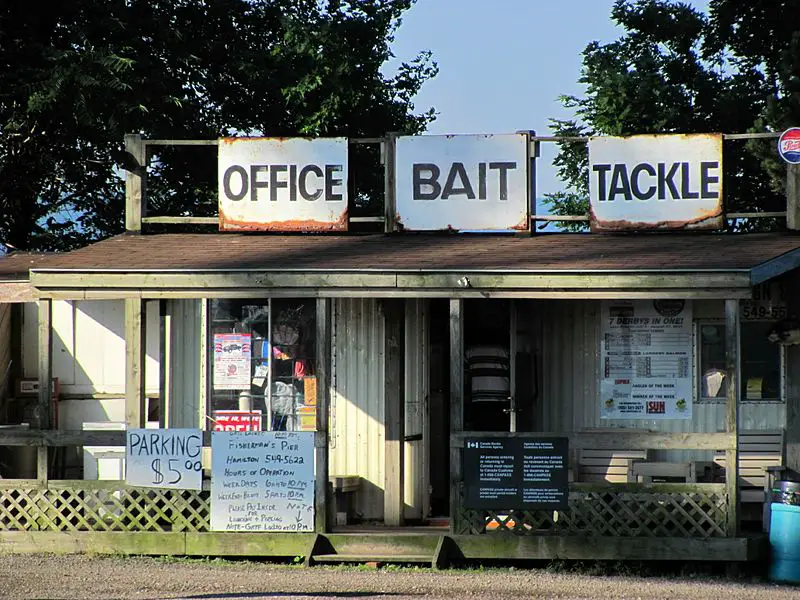
Woods Canyon Lake Store and Marina
Forest road 105, Woods Canyon Road US Highway 260, Mile Marker 282, FR 300, Forest Lakes Estates, AZ 85931
(480)586-5660
Forest Lakes General Store
2998 AZ-260, Forest Lakes Estates, AZ 85931
(928)535-4716
Ace Hardware
2837 AZ-260, Overgaard, AZ 85933
(928)535-6335
Sportsman’s Warehouse
4421 S White Mountain Rd, Show Low, AZ 85901
(928) 537-0800
White Mountain Bait & Tackle
1300 W McNeil, Show Low, AZ 85901
(928) 537-2402
M&M Kayaks
1488 E White Mountain Blvd, Pinetop, AZ 85935
(928) 358-1183
Hon Dah Ski & Outdoor Sport
787 AZ-260, Pinetop, AZ 85935
(928) 369-7669
Places to Camp, Lodging and RV parks
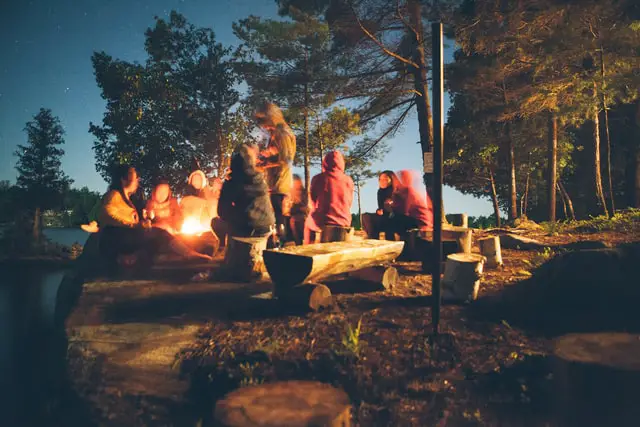
Spillway Campground
- Location: Forest Service Rd 105, Payson, AZ 85541
- (928) 535-9859
- Sites: 26
- Tents, trailers and small motorhomes are allowed
- Please read information on each individual spur size to determine if your RV will fit in the site.
- Low season: October – March
- High season: April – September
- Concrete pads: Yes
- Pets welcome: Yes
- Fire ring: Yes
- Picnic table: Yes
- Nearby gas: Yes
- Nearby place to buy firewood: Yes
- Nearby place to buy groceries: Yes
- Campground map – click here
- Reservations – click here
Woods Canyon Lake Group Campground
- Location: Forest Lakes Estates, AZ 85931
- phone: none
- Sites: 1
- Serves large groups of up to 100 people
- Low season: October – March
- High season: April – September
- Concrete pads: Yes
- Pets welcome: Yes
- Fire ring: Yes
- Picnic table: Yes
- Nearby gas: Yes
- Nearby place to buy firewood: Yes
- Nearby place to buy groceries: Yes
- Campground map – click here
- Reservations – click here
Aspen Campground
- Location: Payson, AZ 85541
- (928)535-7300
- Sites: 148
- Tents, trailers and small motorhomes are allowed
- Please read information on each individual spur size to determine if your RV will fit in the site.
- Low season: October – March
- High season: April – September
- Concrete pads: Yes
- Pets welcome: Yes
- Fire ring: Yes
- Picnic table: Yes
- Nearby gas: Yes
- Nearby place to buy firewood: Yes
- Nearby place to buy groceries: Yes
- Campground map – click here
- Reservations – click here
Crook Campground
- Location: Payson, AZ 85541
- (928)535-9233
- Sites: 2
- Group campground
- The campground is arranged in two loops in a cul-de-sac design.
- Each has a group area that can host up to 110 campers and 26 vehicles (parallel parking only).
- The sites can accommodate both RVs and tents, though some areas are less suited for tent camping.
- Low season: October – March
- High season: April – September
- Concrete pads: Yes
- Pets welcome: Yes
- Fire ring: Yes
- Picnic table: Yes
- Nearby gas: Yes
- Nearby place to buy firewood: Yes
- Nearby place to buy groceries: Yes
- Campground map – click here
- Reservations – click here
Mogollon Campground
- Location: Payson, AZ 85541
- Phone: none
- Sites: 26
- Tents, trailers and small motorhomes are allowed
- Please read information on each individual spur size to determine if your RV will fit in the site.
- Low season: October – March
- High season: April – September
- Concrete Pads: Yes
- Pets welcome: Yes
- Fire Ring: Yes
- Picnic Table: Yes
- Nearby gas: Yes
- Nearby place to buy firewood: Yes
- Nearby place to buy groceries: Yes
- Campground map – click here
- Reservations – click here
Sinkhole Campground
- Location: AZ-260, Payson, AZ 85541
- (928)535-7300
- Sites: 26
- Sites 1 through 13 are first-come, first served.
- Sites 14 through 26 are available for advanced reservation
- There are two accessible sites, two double sites and the rest are single sites.
- All sites are back-in.
- Low season: October – March
- High season: April – September
- Concrete Pads: Yes
- Pets welcome: Yes
- Fire Ring: Yes
- Picnic Table: Yes
- Nearby gas: Yes
- Nearby place to buy firewood: Yes
FR171 Campground
The Apache-Sitgreaves National Forests’ FR 171 Campground is nestled away along Old Rim Rd (FR 171), beyond the Mogollon Rim Visitor Center. Along the forest road, under the towering Ponderosa pines, there are numerous dispersed campsites. All campsites are primitive and there are no hookups.
- Location: Old Rim Rd, Payson, AZ 85541
- (928)333-4301
- Low season: October – March
- High season: April – September
- Concrete Pads: Yes
- Pets welcome: Yes
- Fire Ring: Yes
- Picnic Table: Yes
- Nearby gas: Yes
- Nearby place to buy firewood: Yes
- Nearby place to buy groceries: Yes
- Campground map – click here
- Reservations – first come, first served
Other Activities You Can Do at Woods Canyon Lake
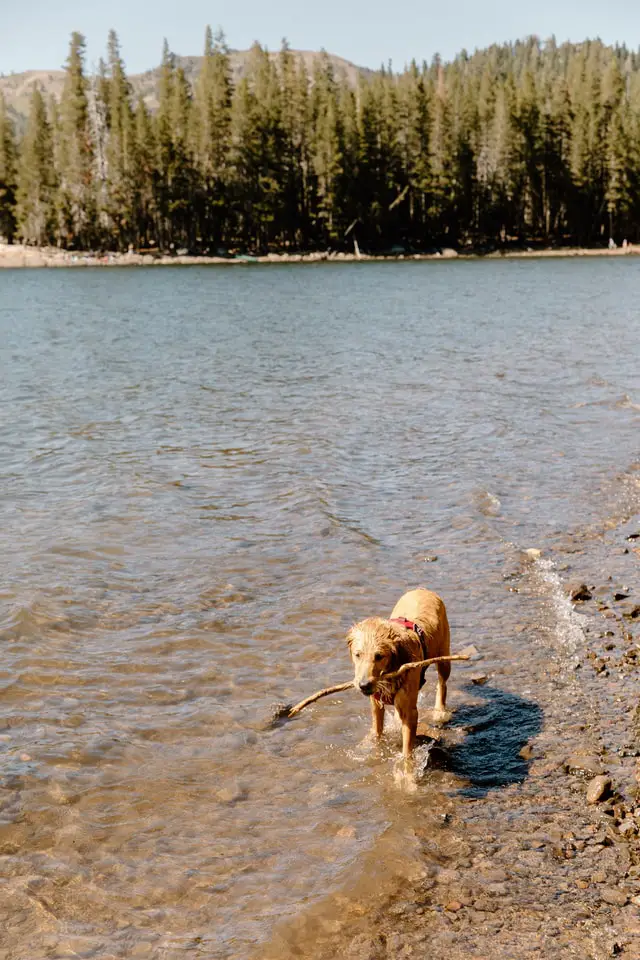
For those who want to chill at the lake…
- Biking
- Bird watching
- Boating
- Skiing
- Kayaking
- Canoeing
- Paddleboarding
- Sailing
- Swimming
- Camping
- Horseshoes
- Picnicking
- Hiking
- Gentle walking trails
- Nature photography trails
- Wildlife viewing
- Mountain biking
- Stargazing
- and most importantly… relaxing.
Other Arizona Related Fishing Articles
- Top 20 Best Places To Fish In Arizona 2023
- Interactive AZ Fishing Map 2023 – Where To Go Fishing In Arizona
- How much does a Arizona fishing license cost?
- Best Tackle Shops In Phoenix Arizona 2023
- Best Bass Fishing Lakes in Arizona 2023 (Voted by Local Anglers!)
- Alamo Lake Fishing Report 2025
- Apache Lake Fishing Report 2025
- Ashurst Lake Fishing Report 2025
- Bartlett Lake Fishing Report 2025
- Bear Canyon Lake Fishing Report 2025
- Big Lake Fishing Report 2025
- Blue Ridge Reservoir Fishing Report 2025
- Canyon Lake Fishing Report 2025
- Chevelon Lake Fishing Report 2025
- Kinnikinick Lake Fishing Report 2025
- Lake Havasu Fishing Report 2025
- Lake Mary Fishing Report 2025
- Lake Pleasant Fishing Report 2025
- Patagonia Lake Fishing Report 2025
- Rainbow Lake Fishing Report 2025
- Roosevelt Lake Fishing Report 2025
- Saguaro Lake Fishing Report 2025
- Show Low Lake Fishing Report 2025
- Sunrise Lake Fishing Report 2025
- Willow Springs Lake Fishing Report 2025
- Woods Canyon Lake Fishing Report 2025
More articles just for you...
Funny Fishing Rules, Laws, and Regulations 2025
Crazy Fishing Laws That Will Blow Your Mind! #7 is INSANE! Strange Fishing Regulations and Laws As silly as hook and rod limits may seem,
EXPOSED! How To Use A Spinnerbait The Right Way for 2025
Are You Wondering How To Use A Spinnerbait? Or How To Work A Spinnerbait Over Grass, Logs, or Points? Well, All These Questions Are Answered
EXPOSED! Best Crankbait Colors for 2025 [Which to Buy & Avoid]
What color crankbait to use? Crankbait Color Chart I just love going into a Bass Pro Shops store and just staring at all the walls
Best Underwater Dock Lights For Fishing – 2025 Buyers Guide
Night Dock Light Fishing For Beginners Dear fellow angler, Does this sound like you? You’re someone who loves fishing but just wants to escape the
15 Best Deep Diving Crankbaits [2025 Buyers Guide – Which to Buy & Avoid]
A Complete Buyer’s Blueprint On The Best Deep Diving Crankbaits for Bass, Walleye, or Striped Bass On The Market Today Fishing deep diving crankbaits can

